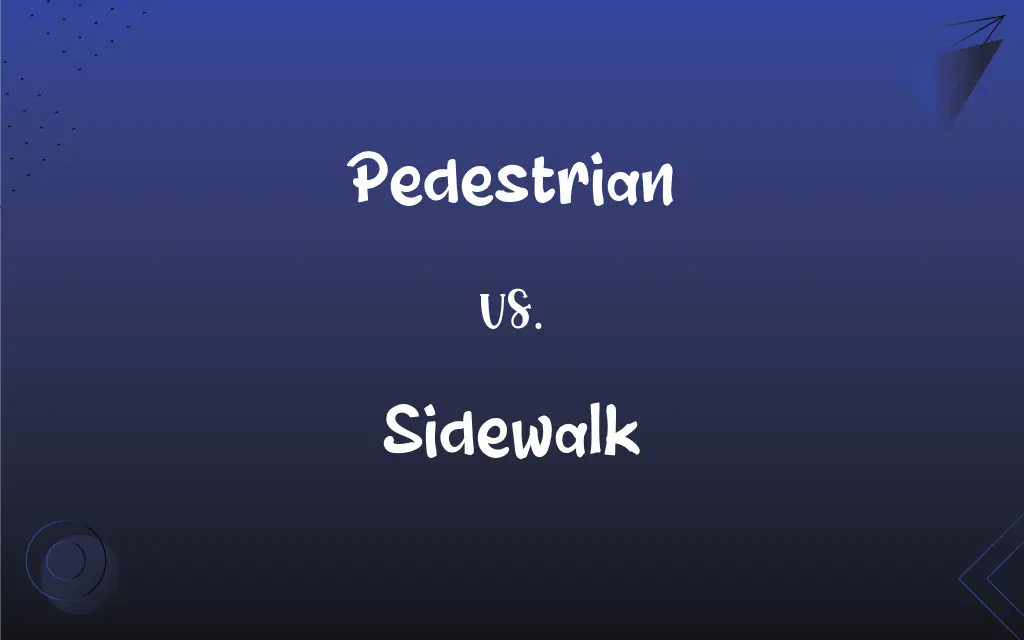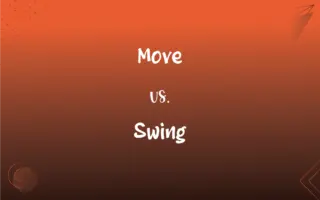Pedestrian vs. Sidewalk: What's the Difference?
By Janet White || Updated on November 11, 2023
A pedestrian is a person walking along a road or in a developed area, while a sidewalk is a paved path for pedestrians alongside a road.

Key Differences
Pedestrian refers to any individual who is walking, especially in an area designed for foot traffic. Sidewalk, on the other hand, is the designated path or pavement beside a street that provides a safe area for pedestrians to walk.
The term pedestrian is used to describe people when they are on foot, as opposed to traveling in vehicles. While, a sidewalk is a structural feature of urban planning, providing a specific space for pedestrian use.
Pedestrians are often discussed in the context of safety, accessibility, and urban mobility. Whereas, sidewalks play a crucial role in ensuring pedestrian safety by separating foot traffic from vehicular traffic.
Pedestrian laws and rights focus on the individuals walking, such as crossing streets or right-of-way. However, sidewalk regulations might involve maintenance, accessibility, and public use policies.
Pedestrians are an integral part of urban and suburban environments, impacting traffic patterns and urban design. Sidewalks are a physical representation of urban planning, reflecting the importance given to pedestrian safety and mobility in a city.
ADVERTISEMENT
Comparison Chart
Definition
A person walking in an urban area or along a road
A paved path for pedestrians alongside a road
Focus
Individual on foot
Structural path for walking
Context
Safety, accessibility, urban mobility
Urban planning, safety, public use
Laws and Rights
Pedestrian laws, crossing streets, right-of-way
Maintenance, accessibility, public policies
Role in Urban Environment
Impact traffic patterns, urban design
Physical aspect of urban planning, reflect pedestrian importance
ADVERTISEMENT
Pedestrian and Sidewalk Definitions
Pedestrian
Someone traveling on foot in a city or town.
Pedestrians crowded the sidewalks during the festival.
Sidewalk
A path along the side of a street for people to walk on.
They strolled down the sidewalk on a sunny day.
Pedestrian
A person walking rather than traveling in a vehicle.
The pedestrian crossed the road at the designated crosswalk.
Sidewalk
A pedestrian walkway beside a road.
Children played hopscotch on the sidewalk.
Pedestrian
Referring to people when they are on foot.
The area is popular among pedestrians for its scenic views.
Sidewalk
A paved walkway for pedestrian use.
The city renovated the sidewalks to make them more accessible.
Pedestrian
A walker, especially in an urban area.
As a pedestrian, she preferred walking to work.
Sidewalk
A concrete or paved path for walking in urban areas.
The sidewalk outside the café was bustling with activity.
Pedestrian
Involving walking, especially in public areas.
Pedestrian traffic increased in the shopping district.
Sidewalk
An urban feature providing safe walking space.
Bicycles are not allowed on the sidewalk.
Pedestrian
A person traveling on foot; a walker.
Sidewalk
A paved walkway along the side of a street.
Pedestrian
Of, relating to, or made for pedestrians
A pedestrian bridge.
Sidewalk
(US) (usually) a paved footpath located at the side of a road, for the use of pedestrians
Pedestrian
Going or performed on foot
A pedestrian journey.
Sidewalk
Any paved footpath, even if not located at the side of a road
Sidewalk
A walk for foot passengers at the side of a street or road; a foot pavement.
Sidewalk
Walk consisting of a paved area for pedestrians; usually beside a street or roadway
FAQs
Where do pedestrians walk?
Pedestrians typically walk on sidewalks, crosswalks, and footpaths.
What rights do pedestrians have?
Pedestrians have rights like crossing streets at crosswalks and right-of-way in certain areas.
What is a pedestrian?
A pedestrian is someone who is walking, especially in a developed area.
What is a sidewalk?
A sidewalk is a paved path for people to walk on, usually alongside a road.
Why are sidewalks important in cities?
Sidewalks provide safe walking spaces, encouraging pedestrian movement and enhancing urban mobility.
Can pedestrians use crosswalks at all times?
Pedestrians should use crosswalks according to traffic signals and safety rules.
Can pedestrians walk in the street?
Pedestrians should walk on sidewalks when available and only on streets when necessary and safe.
Who maintains sidewalks?
Sidewalk maintenance is usually the responsibility of local municipalities or property owners.
How wide are typical sidewalks?
Sidewalk widths vary but typically range from 4 to 6 feet to accommodate pedestrian traffic.
Are sidewalks always paved?
Most sidewalks are paved, but some may have different surfaces like cobblestone.
Are bicycles allowed on sidewalks?
This depends on local laws; some areas permit bicycles on sidewalks, while others do not.
Do sidewalks add value to neighborhoods?
Yes, sidewalks improve walkability and can enhance property values.
Are pets allowed on sidewalks?
Generally, yes, but pets should be on leashes and under control.
Is jaywalking a pedestrian violation?
Yes, jaywalking refers to pedestrians crossing streets unlawfully.
What is pedestrian safety?
Pedestrian safety involves measures to protect walkers from traffic hazards.
Can sidewalks be used for outdoor dining?
In some areas, sidewalks are used for outdoor dining with proper permits.
Do sidewalks reduce traffic accidents?
Yes, sidewalks separate pedestrians from vehicular traffic, reducing accidents.
Are there accessibility standards for sidewalks?
Yes, there are standards to ensure sidewalks are accessible to people with disabilities.
Are pedestrians allowed on highways?
Typically, pedestrians are prohibited on highways for safety reasons.
What is a pedestrian zone?
A pedestrian zone is an area designated solely for foot traffic, often found in urban centers.
About Author
Written by
Janet WhiteJanet White has been an esteemed writer and blogger for Difference Wiki. Holding a Master's degree in Science and Medical Journalism from the prestigious Boston University, she has consistently demonstrated her expertise and passion for her field. When she's not immersed in her work, Janet relishes her time exercising, delving into a good book, and cherishing moments with friends and family.
































































